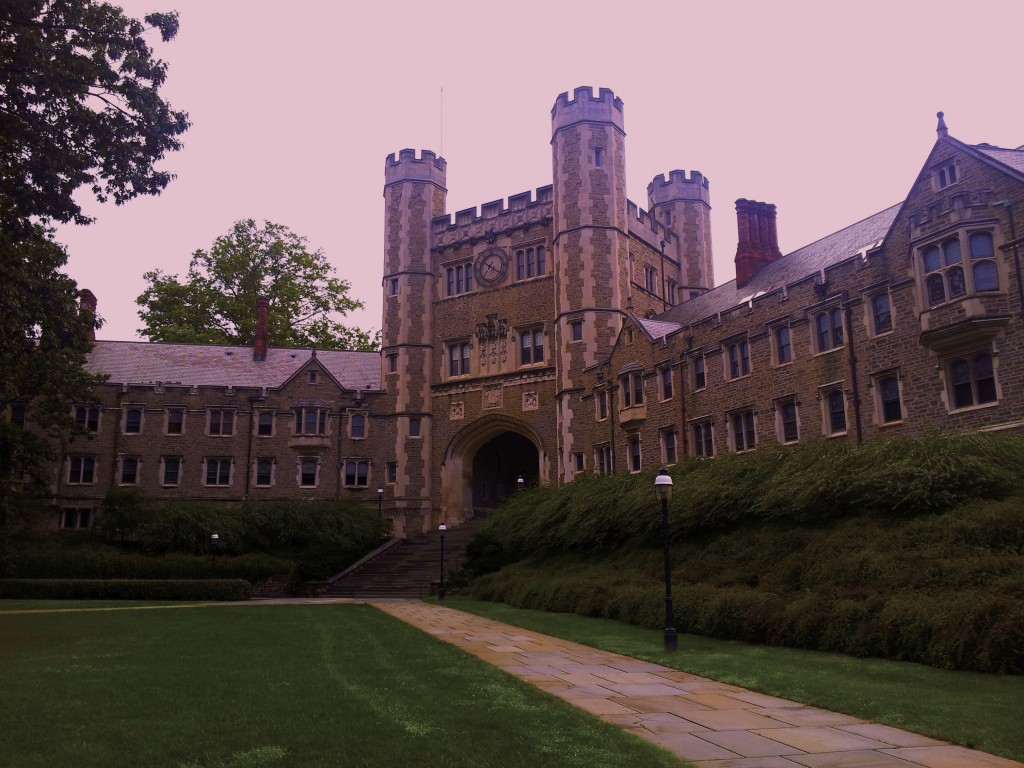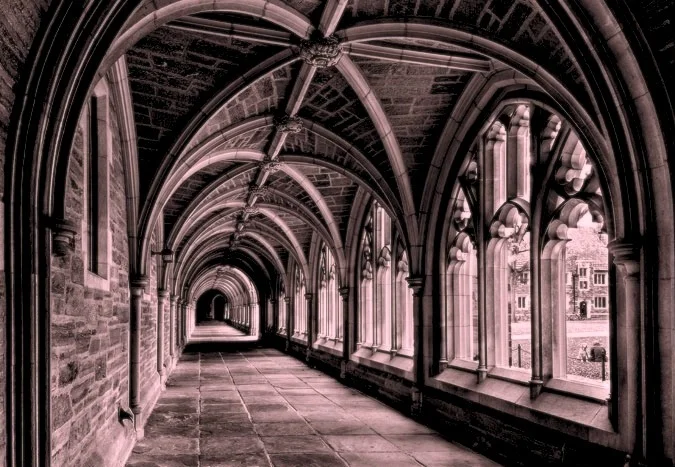106 Degrees of Princeton: Golandsky and the Piano
July 13-20: From Cleveland to Princeton at the Golandsky Institute and International Piano Festival: 23 photos and a diary of observations. “So, why Taubman?”
A mere week in Cleveland separated two trips to Europe, and between these was a week in Princeton I cannot ever forget. This intense week impressed in a lush setting for the Taubman approach for piano at the Golandsky Institute. I truly had no idea what I was about to experience.
Campus gateways–luminous and architecturally magnificent [All photos in this post are my own unless otherwise credited.]
Preparations in Cleveland for Princeton and Europe
The return to reality after spending a week with Martha Argerich and Sergei Babayan at the Lugano Festival was offset by the hosting of a very old friend for the week in Cleveland. We prepared simultaneously for our respective musical projects in rehearsal sessions lasted into the wee hours every night. I wonder how productive the piano world would be, if in fact everybody had such practice buddies.
Sunset light the new Uptown Cleveland construction had the luminous appearance of a wrapped Christo and Jean-Claude installation
Travel and Many Initial Doubts
I must admit that I was flooded with apprehensions that seemed to come from nowhere and everywhere, as I headed to Princeton. “What is the Taubman approach to piano playing, and why do I need to study it intensely for a week?”
Pre-conceived vague notions I had about Taubman going in, for whatever reasons:
-“Only a pedagogical tradition, dogmatic and prescribed onto pianists”
-“Only for injured musicians and certainly not for healthy ones”
-“Somewhat of a cult; looked down upon in the musical world as groupies”
-“Has nothing to do with musicianship but only physicality”
-“No talk about sound”
-“If so many great pianists of the past preceded Taubman, what use is it today, really?”
-“Is this for people who can’t figure things out for themselves? Don’t we have good teachers already?”
-“Why are people so touchy about the subject?”
-“Will my playing be ridiculed for its non-Taubman ways?”
An Edward Hopper-like scene at Penn Station Newark. I was amazed to notice this scene–nobody else paid attention~
During the course of one week, I was realized I was misguided or entirely wrong on all points. So then, why? Why, one asks, did I even go if such questions were forefront in my mind? The answer is simple: I trust senior director and faculty member Bob Durso, my dear friend and musical colleague. Bob is a great pianist and musician–that is the reason I trust all his instincts and accepted his invitation to the Institute. He invited me this past spring to collaborate on a joint concert project in Philadelphia, where I witnessed his artistry firsthand in works by Brahms, and a Bach-Kurtág piece we played as a duet. It was easy to decide that if Taubman is Bob’s tradition, then I had to know what was there.
Appassionata: Robert Durso–his artistry and commitment to teaching are the reason I attended a program I was initially deeply skeptical of, based mostly on passing hearsay. As it turned out, the week was thought-provoking and inspiring.
My –Actual– Experience of Taubman
-Nothing was dictated, prescribed, or dogmatic. All the concepts were offered, simply and easily, as tools for understanding and functional help.
-Everything was offered through a spirit of compassion and sincere desire to help
-Those attending (nearly 200 this year, with many young people) were some of the friendliest people I have met in the field–super intelligent, curious, and supportive. All were passionate in their love of music and learning.
-The faculty radiated a quiet desire to help others in a non-imposing way, and clearly reflected a lifetime of experience.
-All of the teachings, concepts, lectures, and lessons I experienced were based on sound principles and made clear in understanding for those listening.
-I found many friends, old and new, at the Institute, and this was one of the best parts of the experience
-Many of my very accomplished pianist colleagues quietly admit to me they found much learning and help in the principles taught here.
Edna Golandsky teaches a performance masterclass–to my surprise, she did address many musical concerns
Many Photos: views of a historic campus, and a fainting episode story
The beauty of the Princeton setting always amazed me, and so each day I took photos while walking between daily lessons, lectures, masterclasses, meals, and performances.
Before WW1, this was the main gate to Princeton. I walked through its gothic splendor each morning
As it appeared before the war, complete with train tracks for arrival [Princeton Library Archives]
The cloisters at Rockefeller College. This was the walk to the dining hall
The majesty of the campus at Princeton was rendered a bit foreboding by the intense heat and humidity–usually a heat index of 104-106 daily. On Wednesday, walking back to Forbes College, I collapsed to the ground. Fortunately another participant was there to dump water on me, and I had found grass rather than cement as my pillow.
Night of the Living Musicians? …In fact, the daily morning yoga session. Alas, on account of the weather, I only attended once. Many aspects of a musician’s life were considered in this complete approach to wellness. The campus looked like a country club.
The atmosphere of an ivy-league school prevailed
During the summer months, one can see many foreigners posing in front of the buildings, probably to post to facebook. Many of them are ambitious youngsters who seem to have written all over their faces that they almost own the place–most peculiar. People often seem to puff themselves up around institutional gothic architecture.
Gothic revival details
Turn of the century Princeton aesthetic portrait. One doesn’t sense a lack of funds [Library Archives]
F. Scott Fitzgerald was impressed by Princeton’s air of leisurely privilege–although he was a poor student, the experience and his friends influenced his life and work. [google images]
One of the daily lectures on specific aspects of physicality and motion at the piano
Baronial and in heavy Romanesque style, the Richardson Auditorium is where we heard the Philadelphia Orchestra and Ilya Itin’s astonishing recital. Note that one can see the humidity in the air–the day this photo was captured, humidity was 97%
It would be impossible to build with these materials and craftsmanship today on account of labor costs–back then both were inexpensive. Hence, the masterpieces~
A view of some actual ivy–I would have felt ripped off otherwise.
Pompous, bombastic, or impressive? Perhaps all of the above.
Monet: one of the most impressive highlights of the Princeton Museum of Art–full of treasures
Woodrow Wilson at Princeton: he was a leader of the Progressive Movement and was President of Princeton from 1902 to 1910; in 1913 he was elected the 28th President of the United States
For those wishing to explore Princeton gastronomically, there are plenty of choices–first one must mention the best gelato imaginable at the Bent Spoon.
Not everything in Princeton is old and baronial–this hip Mediterranean restaurant boasted exceptional fare
Some initial conclusions about what I observed
Many of the great pianists who preceded Taubman obviously had total command of their instrument. What is less known is that such great examples as Rachmaninov, Schnabel, Gould, Fleisher, and countless silently suffering music students endured injury and dystonia. Independently, many of the technical principles of great playing were arrived at intuitively and through a lifetime of experience by past artists like Rubinstein, Hofmann, and Moiseiwitsch–conclusions explored by Taubman principles. However, the examination and observation of these principles based on hand physiology, far from being clinical and extra-musical though it may sound, contains many items of awareness and shortcuts of understanding for even the most intelligent and intuitively brilliant players. A greater understanding of ease never pre-empted great playing or great musicality. The principles have had great effect on non-injured pianists as well, and many of them have seen great strides in their abilities to solve technical questions. I have seen many people belittle the Taubman approach based on what they think it to be, but perhaps few of them have really fully examined what it has to offer. And what I experienced were a group of dedicated, passionate musicians.
Now, with some new matters of awareness I can observe with exact precision why it was so effortless, and based on what parameters. To internalize many of the concepts at play here does not happen overnight, and must become automatic rather than intellectual–an important distinction.
A rather zen-like September 11 memorial
A Concert to Remember: Ilya Itin at Richardson Auditorium
I grew up collecting recordings of Debussy’s Preludes, especially the second book. I had many favorites–crystalline Michelangeli on DG, Zimerman (up to a point), a brooding Richter live in Spoleto 1967, and sweeping flow from Gieseking. In my estimation, none of those accounts came close to reaching the sonic and musical imagination and rich detail afforded by pianist Ilya Itin at his recital at Richardson Auditorium on Thursday night. It seemed that the pianist in question was casting a spell over the audience with a sense of discovery, narrative surprises, and organic blending of pedal and acoustic planes. Pianistically brandishing astonishing control and command throughout, and his highlighting of harmonic shifts seemed to emphasize departures from the expected. I don’t think I shall soon hear a greater performance of Debussy in my life. I and others in the audience had an edge-of-seat experience of what I can only describe as musical wizardry.
Ilya Itin announces a Rachmaninov encore after a recital of Debussy and Liszt
The Liszt selections in the second half were trenchant and harrowing readings, astonishing in their darkness, contrapuntal emphasis, and pianistic finish. The effect was somewhat analogous to the broad cinematic tableaux of Andrei Tarkovsky–unfolding in a carefully sculpted narrative, culminating in a beauty that is at once majestic and devastated. The Rachmaninov G Major Prelude encore seemed otherworldly and almost as though not on the piano at all, but a celebration of nature and a melancholic love of life.
A scene from Andrei Tarkovsky’s 1986 film “The Sacrifice” [google images]
For more about this special artist Ilya Itin, visit http://www.ilyaitin.com/
For more about the Golandsky Institute, visit http://www.golandskyinstitute.org/
For the PianoFiles with Mark Ainley in daily updates, visit https://www.facebook.com/ThePianoFilesWithMarkAinley
![Campus gateways–luminous and architecturally magnificent [All photos in this post are my own unless otherwise credited.]](https://images.squarespace-cdn.com/content/v1/5c40dffe2714e5d0d8ddee31/1548652095015-48NII6PANOEEFHWDII0Q/campus+gateways)





![As it appeared before the war, complete with train tracks for arrival [Princeton Library Archives]](https://images.squarespace-cdn.com/content/v1/5c40dffe2714e5d0d8ddee31/1548652581493-H3LAZXH9NHNNASWHHWEF/train+tracks)




![Turn of the century Princeton aesthetic portrait. One doesn’t sense a lack of funds [Library Archives]](https://images.squarespace-cdn.com/content/v1/5c40dffe2714e5d0d8ddee31/1548652883126-XX0BHRTJH6O8B5IH12PT/portrait)
![F. Scott Fitzgerald was impressed by Princeton’s air of leisurely privilege–although he was a poor student, the experience and his friends influenced his life and work. [google images]](https://images.squarespace-cdn.com/content/v1/5c40dffe2714e5d0d8ddee31/1548652923985-39G21BYSADYHXPXWSHTD/F.+Scott+Fitzgerald)










![A scene from Andrei Tarkovsky’s 1986 film “The Sacrifice” [google images]](https://images.squarespace-cdn.com/content/v1/5c40dffe2714e5d0d8ddee31/1548994413601-0R2JYPVUO34KZP3SZ5UZ/The+Sacrifice)